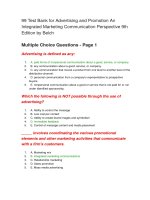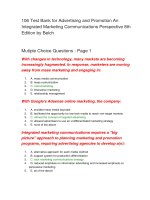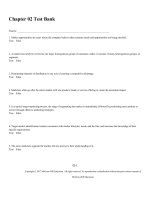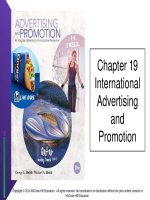Lecture Advertising and promotion: An integrated marketing communications perspective (10/e): Chapter 8 - George E. Belch, Michael A. Belch
Bạn đang xem bản rút gọn của tài liệu. Xem và tải ngay bản đầy đủ của tài liệu tại đây (906.24 KB, 18 trang )
Chapter 8
Creative
Strategy:
Planning and
Development
Copyright © 2015 McGraw-Hill Education. All rights reserved. No reproduction or distribution without the prior written consent of
McGraw-Hill Education.
Determinants of Creativity
Divergence
Relevance
Originality
Ad-to-consumer
Flexibility
Brand-to-consumer
Elaboration
Synthesis
Artistic Value
Copyright © 2015 McGraw-Hill Education. All rights reserved. No reproduction or distribution without the prior written consent of
McGraw-Hill Education.
D’Arcy Masius Benton & Bowles’s
Universal Advertising Standards
Does the advertising position the product simply, with unmistakable clarity?
Does the advertising bolt the brand to a clinching benefit?
Does the advertising contain a Power Idea?
Does the advertising design in brand personality?
Is the advertising unexpected?
Is the advertising single-minded?
Does the advertising reward the prospect?
Is the advertising visually arresting?
Does the advertising exhibit painstaking craftsmanship?
Copyright © 2015 McGraw-Hill Education. All rights reserved. No reproduction or distribution without the prior written consent of
McGraw-Hill Education.
3
Creative versus Hardsell Advertising
Rationalists
Poets
• Advertising must
sell the product
or service
• Advertising must
build an
emotional bond
between
consumers and
brands or
companies
Copyright © 2015 McGraw-Hill Education. All rights reserved. No reproduction or distribution without the prior written consent of
McGraw-Hill Education.
4
Young’s Model of the Creative Process
Immersion
• Gathering raw material and data, and immersing oneself in
the problem
Digestion
• Analyzing the information
Incubation
• Letting the subconscious do the work
Illumination
• Birth of an idea
Reality or verification
• Studying the idea and reshaping it for practical usefulness
Copyright © 2015 McGraw-Hill Education. All rights reserved. No reproduction or distribution without the prior written consent of
McGraw-Hill Education.
5
Wallas’ Model of the Creative Process
Preparation
• Gathering background information needed to solve the
problem through research and study
Incubation
• Letting ideas to develop
Illumination
• Finding the solution
Verification
• Refining the idea and analyzing whether it is an
appropriate solution
Copyright © 2015 McGraw-Hill Education. All rights reserved. No reproduction or distribution without the prior written consent of
McGraw-Hill Education.
6
General Preplanning Input
Gather and organize information on
the product, market, and competition
Analyze the trends, developments,
and happenings in the marketplace
Copyright © 2015 McGraw-Hill Education. All rights reserved. No reproduction or distribution without the prior written consent of
McGraw-Hill Education.
7
Product or ServiceSpecific
Preplanning Input
Gathering information through studies conducted by the
client
Problem detection
Psychographic studies
Branding research
Copyright © 2015 McGraw-Hill Education. All rights reserved. No reproduction or distribution without the prior written consent of
McGraw-Hill Education.
8
Input Verification and Revision
Objective
Objective
Techniques
Techniques
••Evaluate ideas
Evaluate ideas
••Reject the inappropriate
Reject the inappropriate
••Refine the remaining
Refine the remaining
••Give ideas final expression
Give ideas final expression
••Directed focus groups
Directed focus groups
••Message communication studies
Message communication studies
••Portfolio tests
Portfolio tests
••Viewer reaction profiles
Viewer reaction profiles
Copyright © 2015 McGraw-Hill Education. All rights reserved. No reproduction or distribution without the prior written consent of
McGraw-Hill Education.
Storyboards and Animatics
Copyright © 2015 McGraw-Hill Education. All rights reserved. No reproduction or distribution without the prior written consent of
McGraw-Hill Education.
An Advertising Campaign
Integrated
Integrated
Interrelated
Interrelated
In Different Media
In Different Media
Marketing
Marketing
Communication
Communication
Activities
Activities
Centered on a Theme
Centered on a Theme
or Idea
or Idea
Coordinated
Coordinated
Over a Time
Over a Time
Period
Period
Copyright © 2015 McGraw-Hill Education. All rights reserved. No reproduction or distribution without the prior written consent of
McGraw-Hill Education.
Advertising Campaign Themes
The central message that will be communicated
The central message that will be communicated
in all of the various IMC activities
in all of the various IMC activities
Miller
Miller
Nike
Nike
Lite
Lite
““ Just Do It”
Just Do It”
Under Armour
BMW
Under Armour
BMW
““ We Must
We Must
Protect This
Protect This
House. I will.”
House. I will.”
Red Bull
Red Bull
““Red Bull Gives
Red Bull Gives
You Wings
You Wings””
Copyright © 2015 McGraw-Hill Education. All rights reserved. No reproduction or distribution without the prior written consent of
McGraw-Hill Education.
Criteria for Effective Slogans
Copyright © 2015 McGraw-Hill Education. All rights reserved. No reproduction or distribution without the prior written consent of
McGraw-Hill Education.
Figure 8.3 Creative Brief Outline
Copyright © 2015 McGraw-Hill Education. All rights reserved. No reproduction or distribution without the prior written consent of
14
McGraw-Hill Education.
Figure 8.4 Model of Marketing Information Flow
from the Marketing Manager to the Creative Staff
Source: John Sutherland, Lisa Duke, and Avery Abernethy, “A Model of Marketing Information Flow,” Journal of Advertising 33, no. 4 (Winter 2004), p.
42. Copyright © 2004 by American Academy of Advertising. Reprinted with permission of M. E. Sharpe, Inc. All rights reserved. Not for reproduction.
Copyright © 2015 McGraw-Hill Education. All rights reserved. No reproduction or distribution without the prior written consent of
15
McGraw-Hill Education.
Developing the Major Selling Idea
Using a unique
selling proposition
Creating a brand
image
Approache
s
Finding the
inherent drama
Positioning
Copyright © 2015 McGraw-Hill Education. All rights reserved. No reproduction or distribution without the prior written consent of
16
McGraw-Hill Education.
The Unique Selling Proposition
(USP)
Benefit
Benefit
Buy this
Buy this
product/servic
product/servic
e and you get
e and you get
this benefit
this benefit
Unique
Unique
Must be unique
Must be unique
to this brand or
to this brand or
claim; rivals
claim; rivals
can't or don't
can't or don't
offer it
offer it
Potent
Potent
Promise must
Promise must
be strong
be strong
enough to
enough to
move mass
move mass
millions
millions
Copyright © 2015 McGraw-Hill Education. All rights reserved. No reproduction or distribution without the prior written consent of
McGraw-Hill Education.
Positioning
Establishes the product or service in a particular
place in the consumer’s mind
Done on the basis of a distinctive attributes
Basis of a firm’s creative strategy when it has
multiple brands competing in the same market
Copyright © 2015 McGraw-Hill Education. All rights reserved. No reproduction or distribution without the prior written consent of
18
McGraw-Hill Education.









